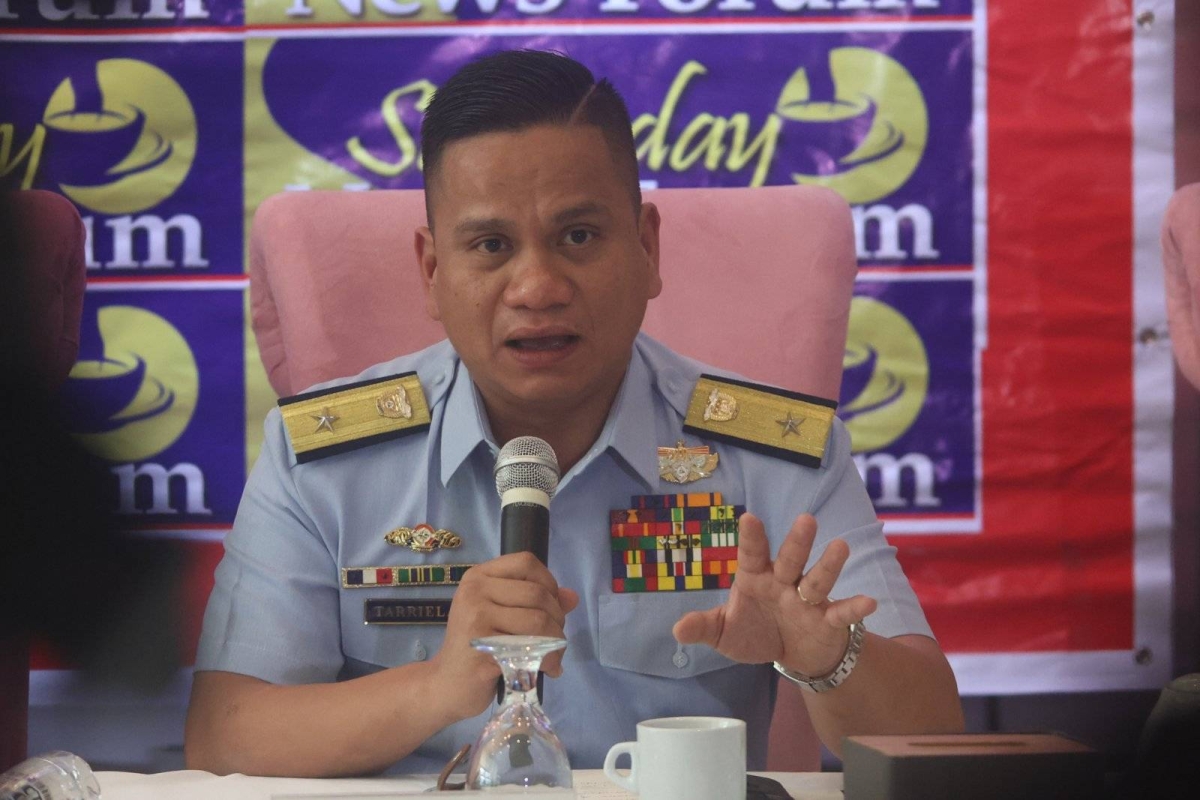
THE Pag-asa Cays in the West Philippine Sea (WPS) are in a "degraded" state with low coral and fish diversity and abundance, according to the findings of marine scientific research carried out by the Philippines.
In a media briefing on Saturday, Dr. Jonathan Anticamara from the University of the Philippines Institute of Biology said the degradation of the reef biodiversity in Pag-asa Island Cays 1, 2, 3 and 4 was possibly due to a combination of disturbances from overfishing, climate change impact and island-building activities in several features in the WPS.
Based on the findings, the Pag-asa Cays have less than 10 coral and fish species per 100 square meters, and those observed were small in size.
Anticamara also said that the pile of sand and rubble on Pag-asa Cays 1, 2 and 3 have many characteristics that were atypical of naturally formed or sandy barrier islands.
He said this indicated that these were caused by island-building activities that were observed in the WPS "but with some degree of uncertainty."
The study further revealed that Pag-asa Cays 1, 2 and 3 have steeper slopes compared to naturally formed islands and have coral rubble that was distinct from the coral rubble underwater. 'DEGRADED ISLAND' Cmdre. Jay Tarriela, spokesman for the National Task Force-West Philippine Sea, presents the results of a Marine Resources Assessment conducted on Pag-asa Island in March. In a press conference on Saturday, May 4, 2024, Tarriela, along with Jay Batongbacal, a maritime law expert, and Dr. Jonathan Anticamara of the University of the Philippines Institute of Biology, said that the island near the WPS was in a 'degraded' state with low coral and fish diver 'DEGRADED ISLAND' Cmdre. Jay Tarriela, spokesman for the National Task Force-West Philippine Sea, presents the results of a Marine Resources Assessment conducted on Pag-asa Island in March. In a press conference on Saturday, May 4, 2024, Tarriela, along with Jay Batongbacal, a maritime law expert, and Dr. Jonathan Anticamara of the University of the Philippines Institute of Biology, said that the island near the WPS was in a 'degraded' state with low coral and fish diver 'DEGRADED ISLAND' Cmdre. Jay Tarriela, spokesman for the National Task Force-West Philippine Sea, presents the results of a Marine Resources Assessment conducted on Pag-asa Island in March. In a press conference on Saturday, May 4, 2024, Tarriela, along with Jay Batongbacal, a maritime law expert, and Dr. Jonathan Anticamara of the University of the Philippines Institute of Biology, said that the island near the WPS was in a 'degraded' state with low coral and fish diver 'DEGRADED ISLAND' Cmdre. Jay Tarriela, spokesman for the National Task Force-West Philippine Sea, presents the results of a Marine Resources Assessment conducted on Pag-asa Island in March. In a press conference on Saturday, May 4, 2024, Tarriela, along with Jay Batongbacal, a maritime law expert, and Dr. Jonathan Anticamara of the University of the Philippines Institute of Biology, said that the island near the WPS was in a 'degraded' state with low coral and fish diver 'DEGRADED ISLAND' Cmdre. Jay Tarriela, spokesman for the National Task Force-West Philippine Sea, presents the results of a Marine Resources Assessment conducted on Pag-asa Island in March. In a press conference on Saturday, May 4, 2024, Tarriela, along with Jay Batongbacal, a maritime law expert, and Dr. Jonathan Anticamara of the University of the Philippines Institute of Biology, said that the island near the WPS was in a 'degraded' state with low coral and fish diver
Anticamara said that the coral rubble found in the cays was not covered by algae, as was the case with coral rubble from the immediate vicinity underwater.
He said these were "too tall or too large" to be piled up from coral rubble in the immediate vicinity underwater.
In addition, the cays have coral rubble that appeared mysteriously in the middle and were not distributed on the edges of the pile.
Anticamara said the cays also have sections where coral rubble was piled on large live coral colonies, suggesting that these were dumped.
He said most of these live corals that were observed 7 to 15 meters deep were "small massive forms with few live digitate and branching forms."
Only a few branching and foliose coral species were found in shallow sections in Pag-asa Cay 2, Anticamara said.
The marine research assessment also found only small fishes in the cays that were 50 centimeters in length.
Anticamara said this was the first time that marine research was conducted in the area.
Responsible party
Commo. Jay Tarriela, Philippine Coast Guard (PCG) spokesman for the WPS, said while the findings did not explicitly identify China as the responsible party, "only China has access to these cays, which are located near their reclaimed military base on Subi Reef."
"If you are going to ask me now, who is our suspect in doing these illegal small island reclamation in Cays 1,2,3,4? There's no other country that we can pinpoint; it's only the People's Republic of China," said Tarriela.
He said China has a history of extensive island-building in the South China Sea, disregarding the preservation of giant clams and coral reefs that have developed over decades.
"Their actions demonstrate a lack of concern for the marine ecosystem to maintain their presence in the region," he said.
Tarriela also said that the China Coast Guard and Chinese Maritime Militia vessels were frequently observed swarming these cays.
During their exploration, he said there were no vessels from other countries that were cited sailing in the vicinity waters off the Pag-asa Cays.
"Our embedded media personnel can confirm the absence of Vietnamese, Malaysian or Indonesian-flagged vessels," said Tarriela.
He further claimed that China had restricted their team from conducting the marine research and assessment and that these restrictions hindered the completion of the survey.
"Our team was subjected to dangerous maneuvers of the China Coast Guard and even as far as deploying a People's Liberation Army-Navy helicopter to prevent our marine scientist from gathering data," Tarriela said.
He said this behavior indicated China's opposition to the marine scientific research conducted by the Philippines.
"It suggests that they may be concealing ongoing small-scale reclamation activities in the cays surrounding Pag-asa Island."
The marine research commenced last March 21.
However, Herman Tiu Laurel, Asian Century Philippines Strategic Studies Institute president, said that Tarriela admitted that his insinuations casting aspersions on China, in particular, on the alleged sad state of Pagasa Cays, was "baseless and pure biased speculation."
"It just reaffirms the prejudice and bias of [Tariela], who has been proven wrong so many times about his claims against China," Laurel told The Manila Times.
He said that over the years, information on illegal fishing has been reported by Philippine media, the latest of which was on June 14, 2023, by Vietnamese fishermen in the area of Pag-asa Island.
"China is the foremost South China Sea state that has been the most active party in implementing a self-imposed annual fishing moratorium or its fishing fleet to preserve the richness and diversity of the fisheries in the area," Laurel said.
"[Tarriela] should refrain from making unfounded megaphone accusations that further complicate the already problematic situation," he added.
PH-China unwritten agreement
As the Philippines revealed the findings of its latest research in the disputed area, China publicized what it claimed was an unwritten 2016 agreement with Manila over access to South China Sea islands.
The move threatens to further raise tensions in the disputed waterway, through which much of the world's trade passes and which China claims virtually in its entirety.
A statement from the Chinese Embassy in Manila said the "temporary special arrangement" agreed to during a visit to Beijing by former president Rodrigo Duterte allowed small-scale fishing around the islands but restricted access by the military, coast guard, and other official planes and ships to the 12 nautical-mile (22-kilometer) limit of territorial waters.
The Philippines respected the agreement over the past seven years but has since reneged on it to "fulfill its own- political agenda," forcing China to take action, the statement said.
"This is the basic reason for the ceaseless disputes at sea between China and the Philippines over the past year and more," said the statement posted on the embassy's website Thursday, referring to the actions of the Philippines.
President Ferdinand Marcos Jr. and Duterte have denied forging any agreements that would have supposedly surrendered Philippine sovereignty or sovereign rights to China. Any such action, if proven, would be an impeachable offense under the country's 1987 Constitution.
However, after his visit to Beijing, Duterte hinted at such an agreement without offering details, said Collin Koh, a senior fellow at the S. Rajaratnam School of International Studies based in Nanyang Technological University, Singapore, and an expert on naval affairs in the Indo-Pacific region, particularly Southeast Asia.
"He boasted then that he not only got Chinese investment and trade pledges but also that he secured Philippine fishermen access to Scarborough Shoal," Koh said, referring to one of the maritime features in dispute.
Beijing's deliberate wording in the statement "is noteworthy in showing that Beijing has no official document to prove its case and thus could only rely mainly on Duterte's verbal claim," Koh said.
Marcos, who took office in June 2022, told reporters last month that China has insisted that there was such a secret agreement but said he was not aware of any.
"The Chinese are insisting that there is a secret agreement and, perhaps, there is, and I said I didn't, I don't know anything about the secret agreement," said Marcos, who has drawn the Philippines closer to its treaty partner, the US. "Should there be such a secret agreement, I am now rescinding it."
Duterte nurtured cozy relations with Chinese President Xi Jinping during his six-year presidency while openly being hostile to the United States for its strong criticism of his deadly campaign against illegal drugs.
While he took an almost virulently anti-American stance during his 2016 visit to Washington's chief rival, he has said he also did not enter into any agreement with Beijing that would have compromised Philippine territory. He acknowledged, however, that he and Xi agreed to maintain "the status quo" in the disputed waters to avoid war.
"Aside from the fact of having a handshake with President Xi Jinping, the only thing I remember was that status quo, that's the word. There would be no contact, no movement, no armed patrols there, as is where is, so there won't be any confrontation," Duterte said.
Asked if he agreed that the Philippines would not bring construction materials to strengthen a Philippine military ship outpost at the Second Thomas Shoal, Duterte said that was part of maintaining the status quo but added there was no written agreement.
"That's what I remember. If it were a gentleman's agreement, it would always have been an agreement to keep the peace in the South China Sea," Duterte said.
Speaker Martin Romualdez, Marcos' cousin and political ally, has ordered an investigation into what some are calling a "gentleman's agreement."
China has also claimed that Philippine officials have promised to tow away the navy ship that was deliberately grounded in the shallows of the Second Thomas Shoal in 1999 to serve as Manila's territorial outpost. Philippine officials under Marcos say they were not aware of any such agreement and would not remove the now dilapidated and rust-encrusted warship manned by a small contingent of Filipino sailors and marines.
China has long accused Manila of "violating its commitments" and "acting illegally" in the South China Sea without being explicit.
Apart from China and the Philippines, Vietnam, Malaysia, Taiwan and Brunei also have overlapping claims in the sea that is rich in fishing stocks, gas and oil. Beijing has refused to recognize a 2016 international arbitration ruling by a UN-affiliated court in The Hague that invalidated its expansive claims on historical grounds.
Skirmishes between Beijing and Manila have flared since last year, with massive Chinese coast guard cutters firing high-pressure water cannons at Philippine patrol vessels, most recently off Scarborough Shoal late last month, damaging both. They have also accused each other of dangerous maneuvering, leading to minor scrapes.
The US lays no claims to the South China Sea but has deployed Navy ships and fighter jets in what it calls freedom of navigation operations that have challenged China's claims.
The US has warned repeatedly that it's obligated to defend the Philippines — its oldest treaty ally in Asia — if Filipino forces, ships or aircraft come under an armed attack, including in the South China Sea.
Read The Rest at :









